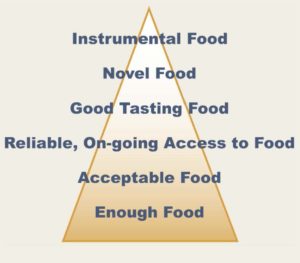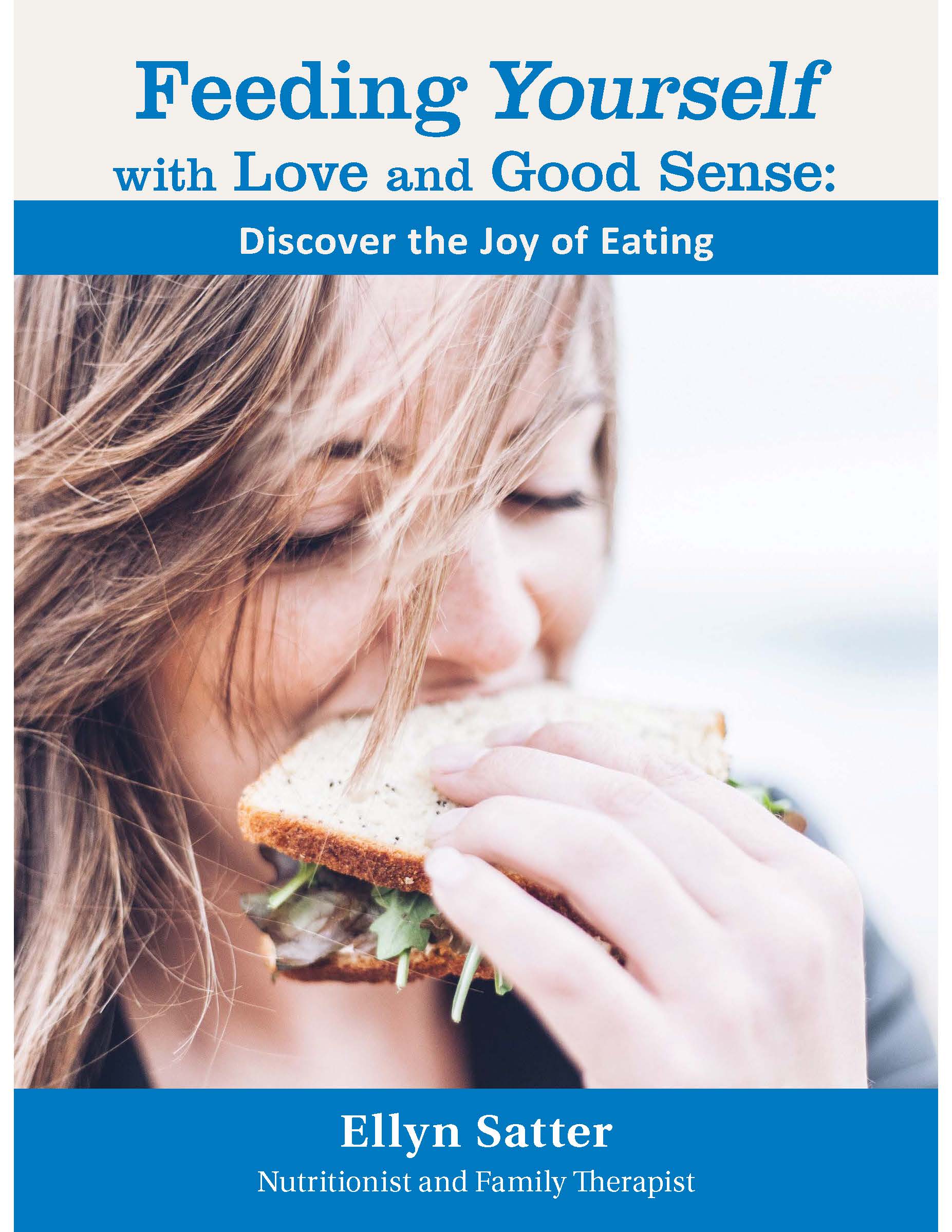

Family Meals Focus
The Ellyn Satter Institute Newsletter
Practicing Nutritional Judo
by Ellyn Satter, MW, MSSW, Dietitian and Family Therapist
For a PDF of this issue of Family Meals Focus, click here
What most of us really want with eating is to eat as much as we want of food we genuinely enjoy. Research with the Satter Eating Competence Model1 indicates that going along with those natural drives rather than struggling against them makes us healthier. People who are Eating Competent do better nutritionally, medically, psychosocially, with respect to parenting with food, and have more positive lifestyle behaviors.2 The Satter Hierarchy of Food Needs3 tells you what to consider as you support your patients – and yourself – in learning and growing with food acceptance.
Prescribed diets overrule what we really want
Since the 1970s, nutrition policy has recommended eating more-than-needed amounts of fruits and vegetables, choosing lean meat, low-fat dairy products, high-fiber food, and strictly limiting high-fat, high-sugar foods. It hasn’t worked: The average Healthy Eating Index score, a measure of adherence to the Dietary Guidelines, has remained below 60%.4
Nutritional judo works because it allows us to trust our inborn energy to learn and grow.
It is difficult to change our diet, but not nearly so difficult to learn to feel bad about what we eat. Consider responses to a typical motivational interviewing question relative to diet, “If you were to change, what would it be like?” Most are likely to say, “eat more fruits and vegetables . . . eat less fast food . . . eat fewer sweets . . . don’t eat so much fried food.” But is that what they really want, or is that what they want to want—or what someone else wants them to want?
What we really want
During my decades of clinical practice, I found my patients couldn’t follow their prescribed diets, and I found out why. Deep in their heart of hearts (or in their taste buds and stomachs), what most people really wanted and needed was eating until they were satisfied of food they genuinely enjoyed and sharing it with people they loved. So why not, I reasoned, practice nutritional judo?
Judo means “the way of gentleness,” and is an orderly and positive method for trusting and making use of one’s own power: one’s own drives. Those are biopsychosocial drives: Hunger and the drive to survive, appetite and the need for pleasure, the social reward of sharing food, and the biological propensity to maintain preferred and stable body weight. I encouraged my patients to trust and respond to their wants and needs rather than trying to resist them, and it was a revelation—and a revolution! People did far better when they trusted heir own wants and needs and freed themselves from eat-this-don’t-eat-that guidelines. They had meals, ate a variety of food, and stopped trying to force their weight down only to have it rebound to a higher level. The Satter Eating Competence Model1 and the Satter Eating Competence Inventory (ecSI 2.0)5 grew out of that clinical judo work. The rapidly accumulating ecSatter research shows that, the same as my patients, people who are Eating Competent, those who respect their food needs and regularly provide themselves with food they enjoy, do better.2
Trust your energy to learn and grow
Nutritional judo works because it allows us to trust our inborn energy to learn and grow. Working with that energy is not random or impetuous, but rather focused and organized. According to Abraham Maslow’s Hierarchy of Needs, growth occurs on its own, in its own time, in sequence. From the foundation through the apex of Maslow’s pyramid-shaped hierarchy of growth, those needs start with basic physiological needs and progress to self-actualization: being all the individual can be.
The JNEB article, Hierarchy of Food Needs (3) translates Maslow’s hierarchy into focused and organized maturation with food acceptance. Judging from its position as the most-often- requested JNEB reprint, the Hierarchy of Food Needs is a concept that has captured the imagination of nutrition professionals. Learning and growing through the levels of the Food Hierarchy depends on ecSatter concepts of permission and positive discipline:
- Permission from you, and permission from themselves, to eat what and as much as they want.
- Positive discipline with respect to taking time to eat and tuning in while eating.
The Steps in the Hierarchy
Growth depends on satisfying in turn needs at each level. A person suffering from food insecurity is stalled at the foundation of the hierarchy. They can’t be expected to adhere to typical nutrition guidance to follow the healthy eating pattern, which is at the apex of the Food Hierarchy, because they haven’t the inner and outer resources. From the bottom to the top, here are the levels of the Food Hierarchy:
- Our most fundamental food need is to get enough, followed closely by having personally acceptable food. Food insecurity, chronic dieting, or being forced to eat unacceptable food prevent maturing beyond this basic level.
- Being able to provide reliable access to food builds on and consolidates the food security achieved at the enough food/acceptable food levels.
- Discriminating appetite grows out of food security: It is the luxury of being able to enjoy eating, rather than having to eat whatever is tolerable and available.
- Interest in novel food grows out of food security and satisfying appetite. It supports eating a variety of food, which is the essence of nutritional quality.
- Considering instrumental food builds on all the rest. This level is optional as far as food security and optimal nutrition are concerned, and adds the element of conscious choice. It is choosing to eat enjoyable food that is also nutritious. In that regard, ecSatter is different from control-based nutritional guidelines, in which enjoyment is an afterthought.
When your patient is stuck
Some people are not able to give themselves permission to eat. They may have been traumatized by food restriction or food insecurity. When they tune in on their eating, especially when they eat food they enjoy, they dip into painful memories, shame, and/or self-criticism. To avoid that inner trauma, many develop a pattern of “eating without eating” – eating fast, impulsively, on automatic pilot, or distracting themselves while they eat.
To help patients resolve their conflict and anxiety about eating, the How to Eat method taught in the Treating the Dieting Casualty workshop uses sophisticated psychosocial techniques. Health professionals can use the techniques without crossing the line into psychotherapy. After three or four sessions, conflict and anxiety subside and internal conflict and chaos transform into orderly and positive eating. After a few more sessions, the patient discovers their stopping place. It is profoundly moving and joyful. Then, they can trust themselves to eat enough, and they can continue the natural processes of learning and growing as described in the Food Hierarchy.
References
- Satter E. Eating Competence: definition and evidence for the Satter Eating Competence Model. J Nutr Educ Behav.2007;39:S142-S153.
- Satter E. The Satter Eating Competence Model: the Satter approach to eating. Ellyn Satter Institute. 2024. https://www.ellynsatterinstitute.org/satter-eating-competence-model/
- Satter E. Hierarchy of food needs. J Nutr Educ Behav. Sep-Oct 2007;39(5 Suppl):S187-188.
- U.S. Department of Health and Human Services, U.S. Department of Agriculture. Dietary Guidelines for Americans.8th Edition. 2020.
- Lohse B. The Satter Eating Competence Inventory for Low-income persons is a valid measure of Eating Competencefor persons of higher socioeconomic position. Appetite. 2015;87:223-228.
Explore
Understand and Apply ecSatter
Treating the Dieting Casualty VISION Workshop
Are you looking for a way to help your clients normalize their relationship with food after years of dieting or disordered eating? This intensive workshop trains professionals in Satter’s How to Eat method. The method has been defined by Ellyn Satter in over 35 years of clinical practice.

Satter Hierarchy of Food Needs


Learn Eating Competence step-by-step
Learn how to eat from this clear, kind, compassionate, entertaining, and matter-of-fact booklet. These forty pages will free you to find the joy of eating and allow you to escape from struggling with your weight.
More about eating
Stay in touch!
Join us on Facebook • Join other professionals in the clinical Facebook group • Subscribe to our email list • Contact us with your questions • Share your success stories with us • Support our mission with your generous donation
